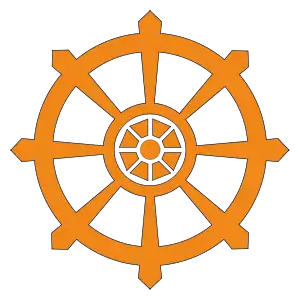| Cheng Hoon Teng Temple | |
|---|---|
.jpg.webp) Front view of Cheng Hoon Teng Temple | |
| Religion | |
| Affiliation | Buddhism, Confucianism, Taoism |
| Location | |
| Location | Malacca City |
| State | Malacca |
| Country | Malaysia |
| Geographic coordinates | 2°11′50.9″N 102°14′48.7″E / 2.197472°N 102.246861°E |
| Architecture | |
| Type | Chinese temple |
| Date established | 1645 |
| Website | |
| www | |
The Cheng Hoon Teng Temple (Chinese: 青云亭; Pe̍h-ōe-jī: Chheng-hûn-tîng) (also called as the Temple of Green Cloud)[1] is a Chinese temple practising the Three Doctrinal Systems of Buddhism, Confucianism and Taoism located at No. 25 Jalan Tokong, Malacca City, Malaysia. It is the oldest functioning temple in the country.[2]
History
The temple site was founded during the era of Dutch Malacca by the Chinese Kapitans Tay Kie Ki Tay Hong Yong in 1645. There are some controversy about the exact time the temple was built. Inscription in the temple recorded the Ming Dynasty calendar Wanli Reign period 28 years might proved the building might be already been there since 1600 or earlier in the 15th Century.[2][3][4] Additional structures were then constructed in 1673 under the leadership of Kapitan Li Wei King Koon Chang with materials imported from China.[5][6][7] The temple served as the main place of worship for the local Hoklo (Hokkien) community. Kapitan Chan Ki Lock constructed a main hall for the temple in 1704.[8] In 1801, the temple structures were renovated under the leadership of Kapitan Chua Su Cheong Tok Ping who was the father of Choa Chong Long, the first Kapitan of Singapore, with the addition of additional structures.[4]
In 1962, then abbot Seck Kim Seng ordained Houn Jiyu-Kennett, a Zen nun from England and the future founder of the Order of Buddhist Contemplatives, at this temple.[9][10] The temple was awarded a UNESCO award for outstanding architectural restoration in 2003.[1]
Features
The temple is situated close to Jalan Tukang Emas, also known as "Harmony Street" because of its proximity to the Kampung Kling Mosque and Sri Poyatha Moorthi Temple, covering an area of 4,600 m2.[2][11][12] Featuring a magnificent main gate along Jalan Tokong, the temple consists of a complex of several prayer halls with a large main prayer hall dedicated to the goddess of mercy, Guan Yin.[2] Additional smaller prayer quarters were added later. One of these is dedicated to the Chinese deities of wealth, longevity and propagation, while another dedicated to ancestral tablets. One of the main features of the temple is the seven-metre red flag-pole facing the left wing of the main prayer hall, which houses the remains of two of the three Kapitans who contributed to the construction of the temple.[2] Across the road is a traditional opera theatre which forms a part of the temple complex. The building conforms to the principles of feng shui where the complex is laid out to ensure a view of the river and high ground on either side.[12]
 An inscription in Chinese characters inside the temple.
An inscription in Chinese characters inside the temple. Information plate about the temple.
Information plate about the temple. One of the stone statue guarding the temple.
One of the stone statue guarding the temple. Roofing art.
Roofing art..jpg.webp) The temple door painting.
The temple door painting. The temple prayer hall.
The temple prayer hall.
See also
References
- 1 2 "Project Profile [2002 Award of Merit] – Cheng Hoon Teng Main Temple (The Temple of Green Cloud)". UNESCO. Archived from the original on 2 February 2009. Retrieved 9 March 2019.
- 1 2 3 4 5 Kenny Mah (11 February 2019). "Jalan Tokong: A stroll down Melaka's harmony street". The Malay Mail. Retrieved 9 March 2019.
- ↑ Jean Elizabeth DeBernardi (2006). The Way that Lives in the Heart: Chinese Popular Religion and Spirit Mediums in Penang, Malaysia. Stanford University Press. pp. 17–. ISBN 978-0-8047-5292-3.
- 1 2 "History of the temple". Cheng Hoon Teng Temple. Archived from the original on 9 March 2019. Retrieved 9 March 2019.
- ↑ Gwynn Jenkins (2008). Contested Space: Cultural Heritage and Identity Reconstructions : Conservation Strategies Within a Developing Asian City. LIT Verlag Münster. pp. 211–. ISBN 978-3-8258-1366-6.
- ↑ Yen Ching-hwang (18 August 2016). Ethnicities, Personalities And Politics In The Ethnic Chinese Worlds. World Scientific. pp. 133–. ISBN 978-981-4603-03-4.
- ↑ "Kapitans of Cheng Hoon Teng". Cheng Hoon Teng Temple. Archived from the original on 9 March 2019. Retrieved 9 March 2019.
- ↑ "Deities". Cheng Hoon Teng Temple. Archived from the original on 9 March 2019. Retrieved 9 March 2019.
- ↑ John Snelling (31 August 2011). The Buddhist Handbook: A Complete Guide to Buddhist Teaching and Practice. Ebury Publishing. pp. 64–. ISBN 978-1-4464-8958-1.
- ↑ Rōshi P.T.N.H. Jiyu-Kennett (5 May 2016). Zen is Eternal Life. Routledge. pp. 209–. ISBN 978-1-317-21468-7.
- ↑ Sameer Das Gupta (1 January 2008). Advanced history of Buddhism: monasteries and temples. Cyber Tech Publications. ISBN 9788178843438.
- 1 2 Aran MacKinnon; Elaine McClarnand MacKinnon (20 March 2012). Places of Encounter, Volume 1: Time, Place, and Connectivity in World History, Volume One: To 1600. Avalon Publishing. pp. 299–. ISBN 978-0-8133-4738-7.
External links
 Media related to Cheng Hoon Teng Temple at Wikimedia Commons
Media related to Cheng Hoon Teng Temple at Wikimedia Commons- Official website



